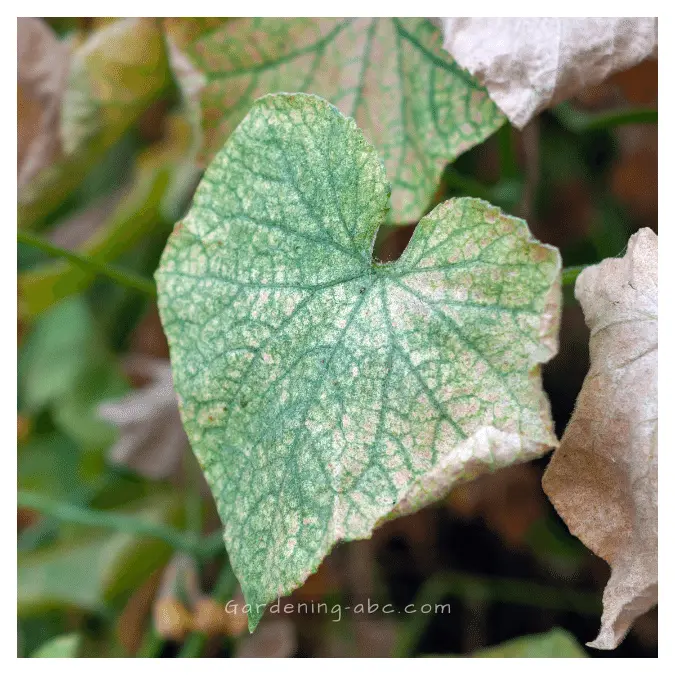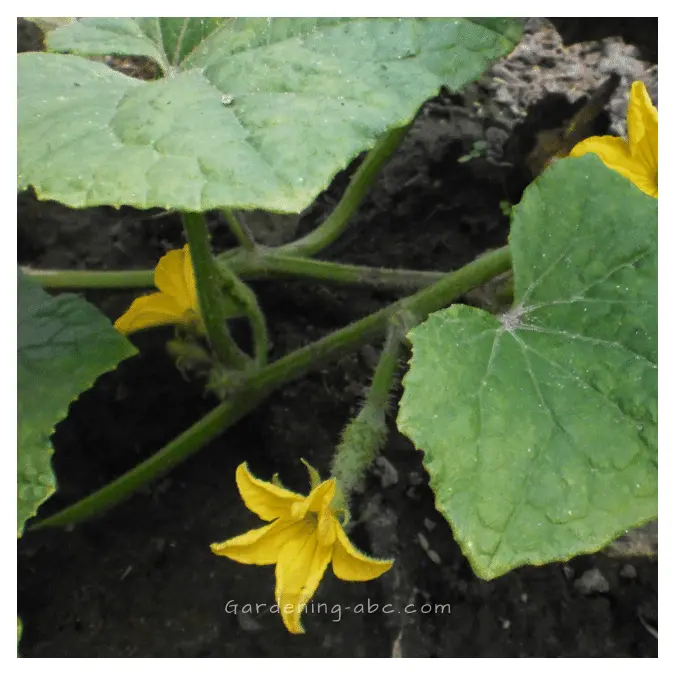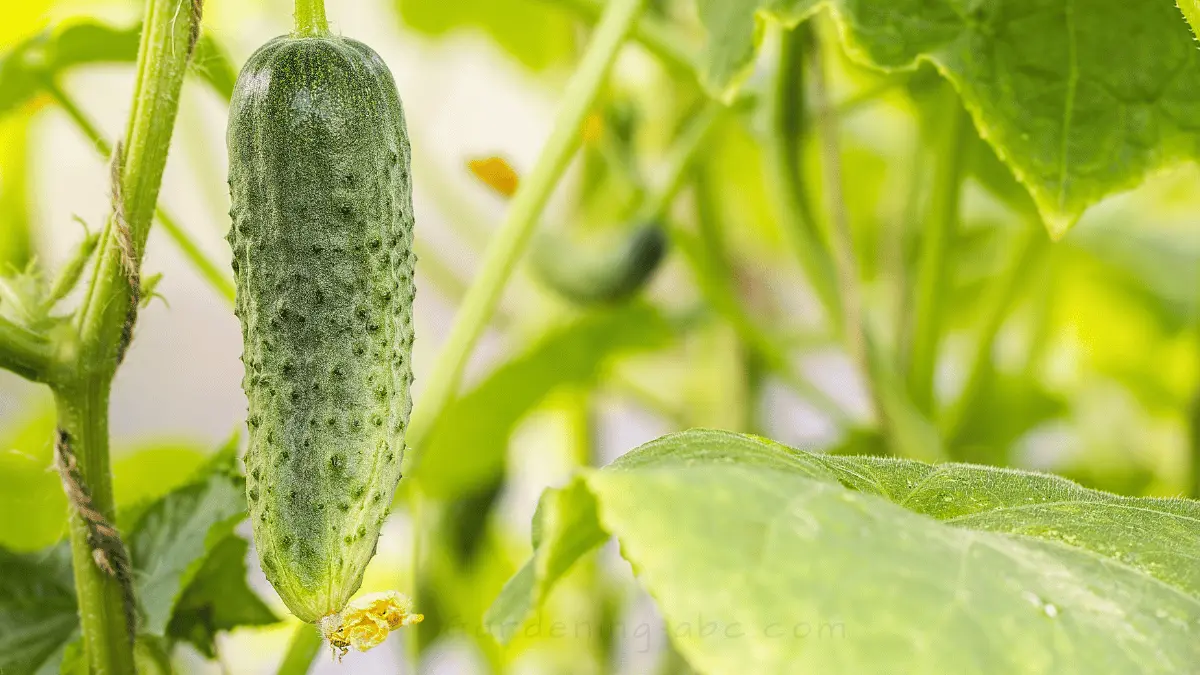We use affiliate links to run our site. When you buy through links on our site, we may earn an affiliate commission, without any added cost to you. Learn more
As a proud owner of a cucumber plant, it’s heart-wrenching to watch your once luscious green cucumber leaves turn white and lifeless. It’s like witnessing the slow demise of a cherished friend. But don’t lose hope just yet! We got your back.
There are numerous reasons why your cucumber leaves turning white, and we’re here to unravel the mystery. In this post, we’ll be delving into the six most common causes for the whitening of cucumber leaves.
From sneaky fungal diseases to unexpected sunburn, we’ll cover it all. Keep reading to discover how to identify the problem and take the necessary steps to revive your beloved cucumber plant.
If you are looking for cucumber-growing tips in general see our earlier post here.
Why There Are White Spots After Transplanting My Cucumber Seedlings:
Cucumber leaves that are turning white after transplanting are suffering from transplant shock. Plants go through a period of stress when they are replaced from one location to another, due to a lack of water and nutrients, as well as changes in temperature or other environmental conditions.
| Cause | Remedy |
|---|---|
| Powdery mildew | Spray the affected plants with a fungicide or make your own by mixing one part baking soda with two parts water. Spray the affected plants with the solution every week until the disease is gone. |
| Pests | Use an insecticidal soap or neem oil. Spray the affected plants with the solution every few days until the pests are gone. |
| Excess moisture | Check the soil moisture level before watering your cucumber plants. The soil should be moist, but not soggy. If the soil is wet, wait a few days before watering again. |
| Accidental blanching | Plant cucumbers in a partially shaded area. |
| Maturity | No treatment is required. |
Why My Cucumber Leaves Turning White at the Edges

There are many reasons why cucumber leaves can turn white. It can be due to some disease, pest infestation, excess moisture, accidental blanching, or simply maturity.
Let’s dig deep into these possible reasons:
1. Diseases
One of the main causes of whitening your cucumber leaves is a disease called powdery mildew.
The Powdery Mildew Disease:
Powdery mildew is the white coating that can cover the entire surface of your cucumber plant, including leaves, stems, and even fruit.
This fungal disease is caused by a lack of air circulation in the plant’s environment or a lack of sunlight. It often begins on older leaves and spreads to younger leaves.
This disease is common in cucumbers, as well as zucchini, pumpkins, and other members of the Cucurbitaceae family.
The disease looks like a white or gray powdery substance on the cucumber plant’s leaves and stems. It usually begins on lower leaves and spreads up the plant.
In severe cases, it can cover most of the leaf surface. The spots appear as grayish-white patches, which enlarge and merge together to form large colonies.
If left untreated, it can cause stunted growth and twisted, distorted leaves. Eventually, the plant will die.
Powdery mildew is difficult to get rid of and you have to take all the precautionary measures necessary not to allow it in your garden.
The spores are carried in the wind and can infect plants quickly if conditions are right. It’s easy to see why this disease is so hard to fight, as it often attacks under the leaves and isn’t noticed until it’s too late.
How to Fight Powdery Mildew Disease:

The white spots produce on the top of leaves are not harmful to the plant but it does reduce the plant’s ability to photosynthesize.
This means that your plant will be getting less sunlight which can prevent proper growth. While this disease doesn’t usually kill plants, it can make them more susceptible to other diseases and even death if left untreated.
The best way to control powdery mildew and other fungal diseases is through prevention and early detection.
The first step is to make sure your cucumber plants are getting enough sunlight, at least 6 hours per day. Keep the plant under direct sunlight. it will help dry out any excess moisture.
Space cucumber plants further apart to promote good air circulation.
Remove any dead plants and debris from your cucumber patch to reduce the spread of spores.
To prevent powdery mildew on cucumber plants, you need to create a homemade fungicide. Mix together 1 tablespoon of baking soda and 1 gallon of water with a squirt of dishwashing liquid.
Use distilled water if your tap water is high in chlorine or minerals, which can harm your plants. Shake the mixture well to evenly distribute the baking soda into the water.
Spray your cucumber leaves with this mixture weekly during warm weather — when temperatures are above 75 degrees Fahrenheit.
Spray both sides of your plant’s leaves thoroughly but avoid getting any solution on the fruit itself, as this may cause it to rot prematurely.
You can also spray the cucumber plants with a solution of 1 tablespoon of baking soda to 1 gallon of water.
Vinegar also works great on fungi. Add 3 tablespoons of vinegar to 1 gallon of water and spray on the leaves. Don’t add too much vinegar to the solution or it will burn the leaves.
2. Pests:
A pest infestation can also be a probable cost for the whitening of cucumber leaves. One such pest is the leafhopper.
Leafhopper (Empoasca spp.):
Leafhoppers can be distinguished from other insects by their wedge-shaped body, small size, and their habit of jumping when disturbed. They suck plant juices from leaves and stems. Leaves turn yellow and curl upward.
There are many organic pest control techniques that you can use to protect your cucumber plant.
A spray made from garlic extract and water might help in severe infestations.
Spider Mites:
Spider mites can harm cucumber plants, making leaves turn white due to damaged chlorophyll cells responsible for photosynthesis. This disrupts food production, stunts growth, reduces fruit yield, and may lead to plant death.
To prevent and manage infestations, inspect regularly, use neem oil or insecticidal soap, and introduce beneficial insects like ladybugs. Act promptly for healthy cucumber plant growth.
Thrips:
Thrips are tiny bugs that like to feed on cucumber leaves and flowers. When they bite into leaves to eat, it damages the plant. Here’s what happens:
Leaves get bronze or silver streaks and spots from the thrips’ bites. This doesn’t look nice.
Young leaves can become twisted or curled up. This stunts the plant’s growth.
With severe thrips damage, the whole plant may be stunted. This means fewer and smaller cucumbers.
Thrips can spread diseases between plants when they feed, like the cucumber mosaic virus. They damage cucumber flowers and fruits too, leaving scars and marks. Less photosynthesis happens when leaves are hurt. This makes less food energy for the plant.

To control thrips:
- Check plants often for tiny bugs. Remove badly infested leaves.
- Bring in good bugs like ladybugs that eat thrips.
- Try insecticidal soap or neem oil sprays.
- Don’t over-fertilize which attracts more thrips.
- Catching thrips early and taking action helps protect cucumbers from these harmful pests. Healthy plants and fruits will grow with proper care.
3. Excess Moisture:
Cucumbers like moist but well-drained soil. If the soil is wet all the time, the roots of the plant can’t get enough oxygen from the soil, so they stop absorbing nutrients from the soil, causing discoloration in the leaves.
Another common problem is excess moisture on the leaves. Water droplets can settle on the leaves and turn them white if they are left sitting there for too long.
This water can also lead to disease since moisture on plant leaves contributes to disease development.
4. Nutrient Deficiency:
Cucumbers are heavy feeders – they need a constant buffet of minerals to really thrive. When the soil can’t provide enough of the good stuff, the plants get stressed. Slow growth, yellowing leaves, poor flowering, and fruiting are all red flags.
The tricky thing is, different deficiencies cause similar symptoms. You’ve gotta test the soil to really know what’s missing. It’s like getting bloodwork done to pinpoint the problem.
I’d suggest sending a sample off to the extension office lab. For a small fee, their experts can analyze everything the dirt’s missing. Or you can grab a DIY test kit for home use – just follow the instructions.
Once you know where the soil’s lacking, it’s easy to choose the right amendments to perk those cucumbers up. Proper nutrition makes all the difference in harvest size and health! No more wimpy plants once they get the minerals they need.
5. Improper Cultural Control:
Sometimes even a lack of space or improper cultural control can result in white spots.
Cucumbers are sensitive plants, and if you don’t take proper care of them, white spots could appear on the leaves.
They prefer well-drained soil with a pH between 6 and 7. Plant them in full sun if you live in a warm climate, but give them afternoon shade if you live in a warmer area.
They need heat to develop properly, so plant them at least one week after the last frost date. Space each plant at least 1 foot apart so they have plenty of room to spread out their roots.
Water the soil around each plant regularly but avoid getting water on the leaves because it can cause fungus problems.
Here are the full details of the ideal growing environment for cucumbers.
6. Accidental Blanching:
One of the most common causes of cucumber leaves turning white is accidental blanching. Accidental blanching occurs when you cover the cucumbers with heavy foliage.
Some gardeners like to blanch their cucumbers by burying them in straw or otherwise preventing sunlight from reaching the fruit as it grows.
However, sometimes they accidentally blanch their plants by completely covering them with mulch or straw. This can prevent the roots from getting enough oxygen, causing white, pale leaves.
Accidental blanching will result in less chlorophyll in those leaves and white or yellowish color which is not desirable in cucumbers.

7. Natural Aging Process:
Cucumber plants naturally turn white as they age and begin producing seeds. When they begin producing seed pods, they take nourishment away from their production of fruit and reallocate it towards seed production.
This causes pale yellow or white-colored leaves.
Can Cucumber Plants Survive With White Leaves?
Cucumber plants with white leaves may survive, but they may not produce healthy fruits. The white leaves are a symptom of an underlying issue, such as a fungal infection like powdery mildew, pest infestations, overwatering, inadequate sunlight, or transplant shock.
Whatever the reason, white leaves mean the plant can’t properly photosynthesize or make enough food energy. It’s like forcing an athlete to compete without good nutrition – bad idea! The plant survives but isn’t thriving.
Your goal is to get to the root of the problem and fix it. Check closely for fungi and bugs. Feel how damp the soil is and move to a sunnier spot if needed. Go easy on newly transplanted plants. Address the issue specifically, and the leaves may recover their green color in time.
But there could still be lasting effects, especially if the leaves stayed white for long. The plant may struggle to support big, robust cucumbers. Don’t be shocked if the harvest is lower quality or quantity this season. Chalk it up as a lesson for the next round! At least now you know to take action at the first sign of trouble.
Conclusion:
There are a lot of possible reasons for white spots on cucumber leaves. so finding out the actual reason is crucial for the survival of the plant. By following the steps we’ve outlined in this article, you can now successfully diagnose and treat the issue, and keep your cucumber plant thriving.
Taking care of plants is not just a hobby, it’s a responsibility. Take action today and give your cucumber plant the love and care it deserves.
If you found this post helpful, please consider sharing it with fellow gardeners who may be experiencing the same issue. Also, check out our other informative articles on this site for more gardening tips and tricks.
Amazon and the Amazon logo are trademarks of Amazon.com, Inc, or its affiliates.

Hi there! My name is Prasenjit and I’m an avid gardener and someone who has grown a passion for growing plants. From my hands-on experience, I have learned what works and what doesn’t. Here I share everything I have learned.
